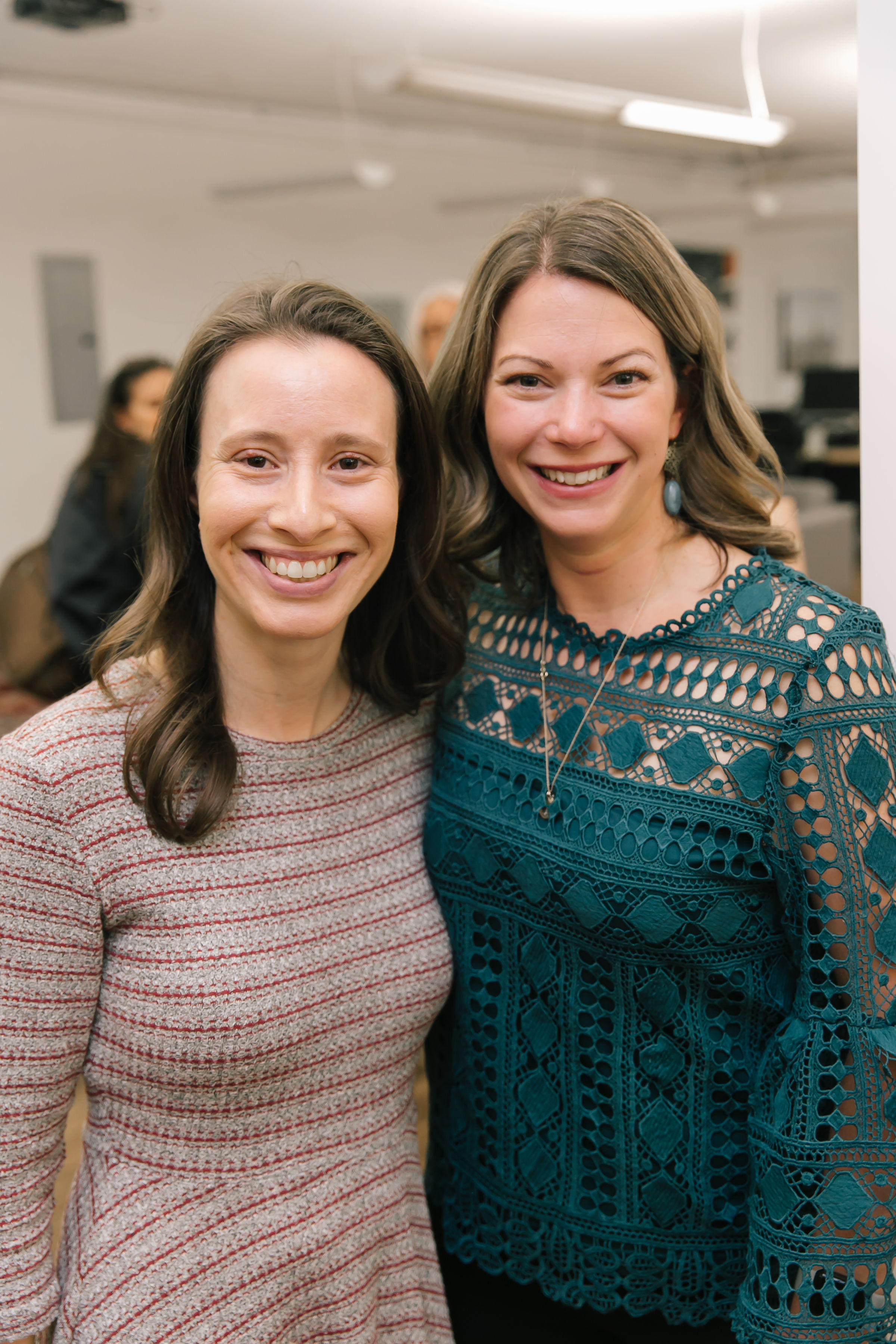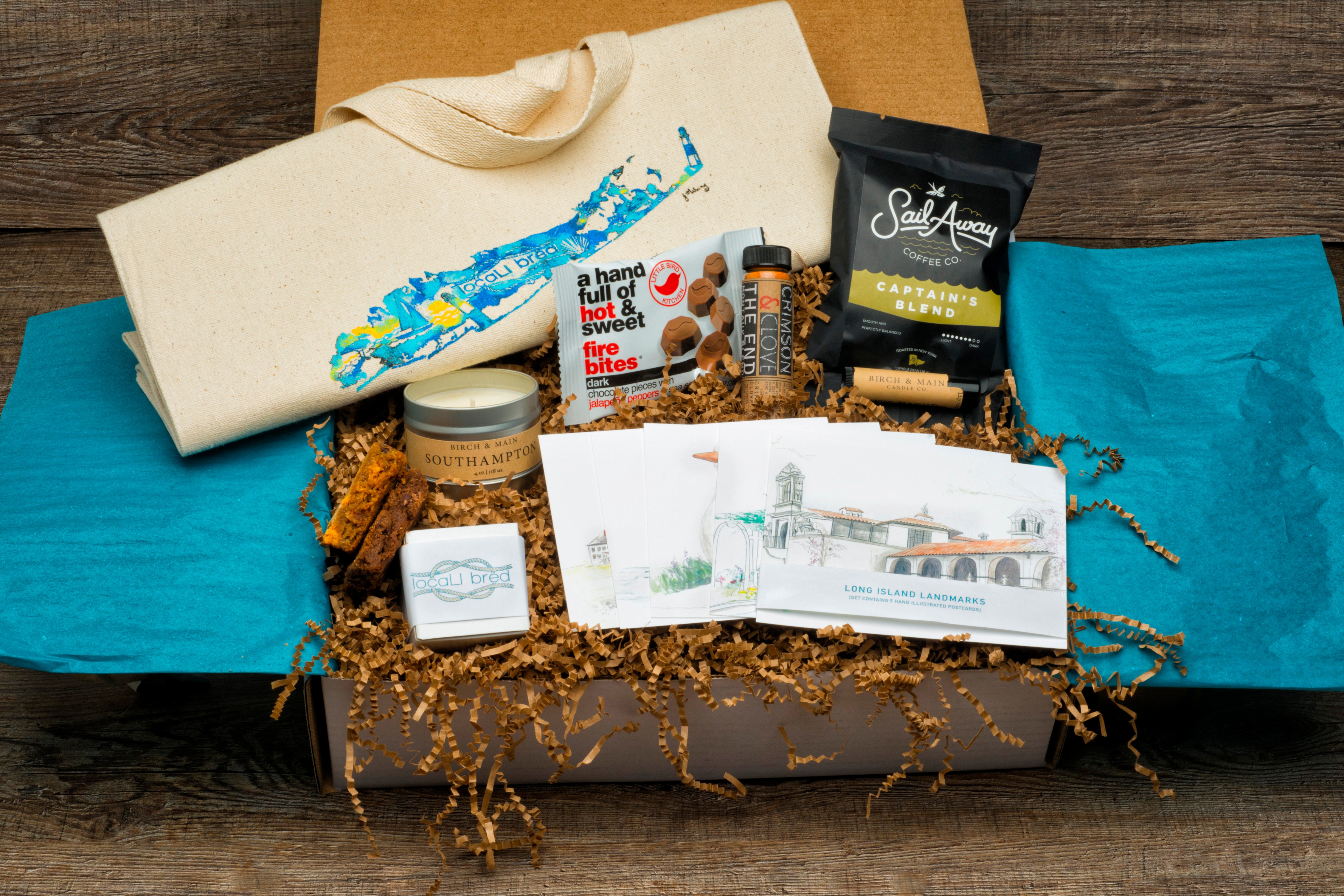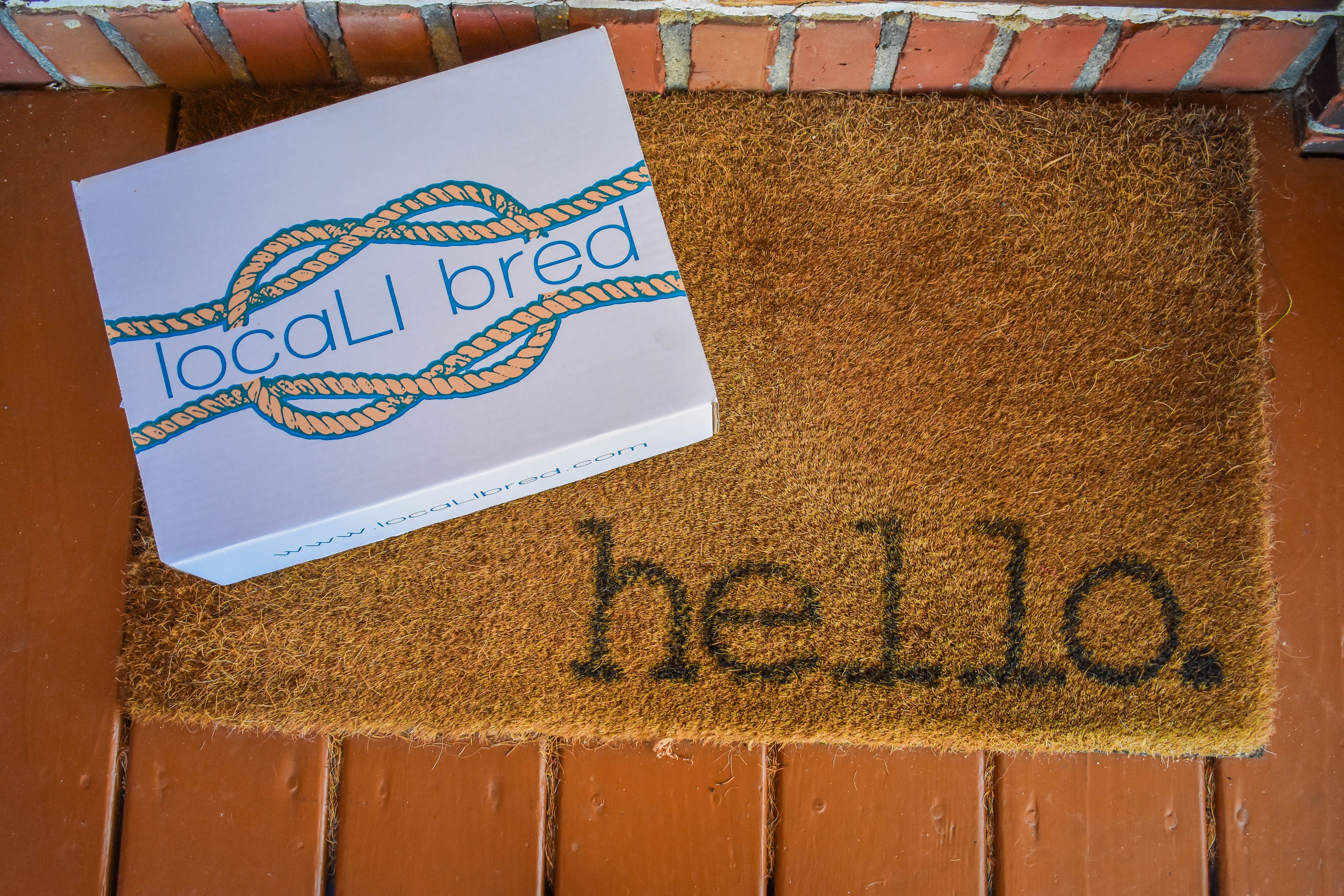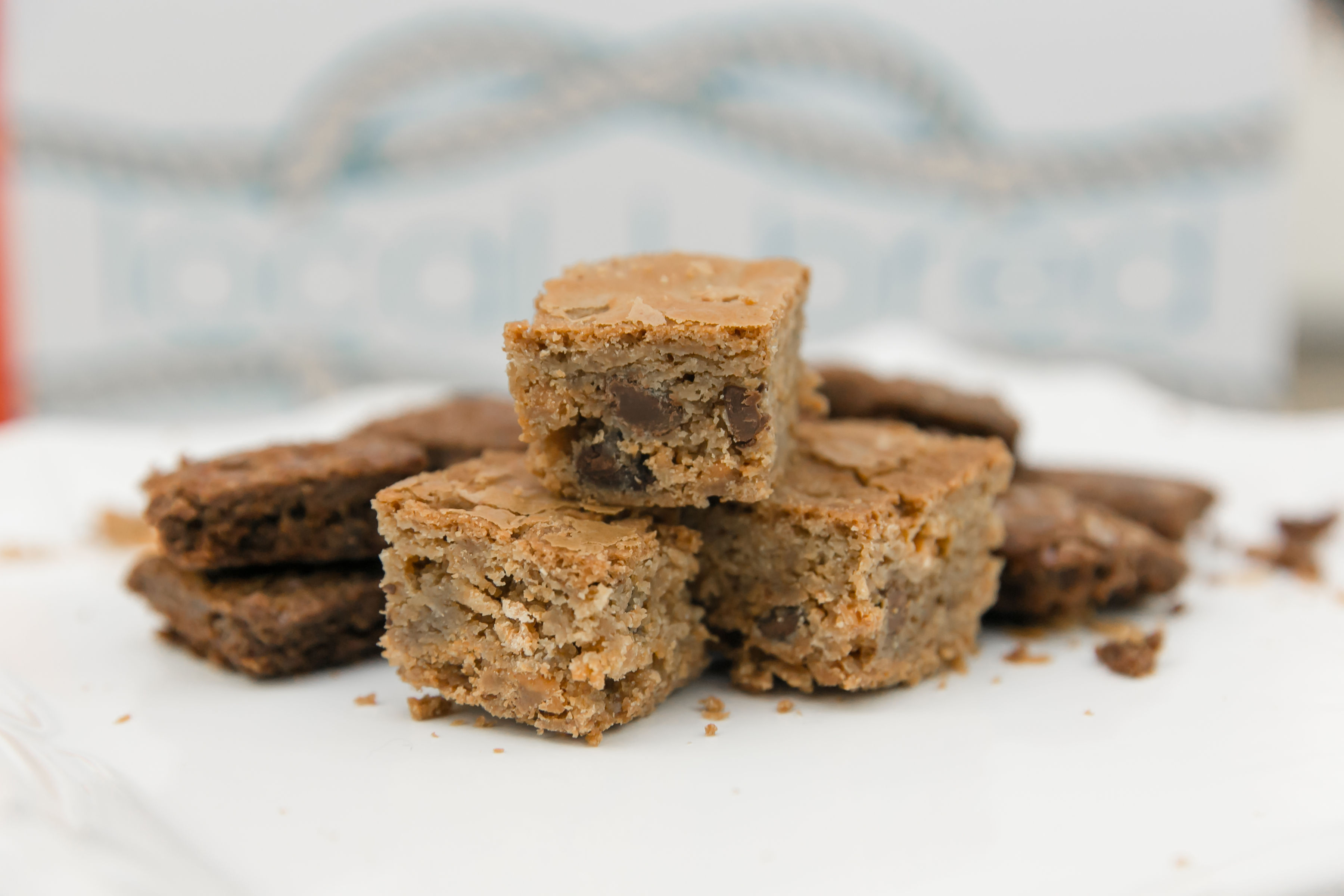
I started to see the name “locaLI bred” everywhere; on Instagram, in coffee shops, on Long Island blogs. They became known among the community in what seemed like over night.
They had graciously agreed to meet me for this interview at the Huntington Book Revue; a table for three inside the little cafe that has become their favorite place for business meetings and strategizing.
Halie Geller (right), a former International trade attorney, and Theresa Pinelli (left), a former small business marketer for American Express, had found their new homes in Huntington around the same time. “We were destined to be friends” says Halie. Personalities and shared experience that mesh so well together, their friendship is a staple to their success.
They had come up with the idea for a curated box showcasing Long Island businesses last April. With no network, website, business cards, or reputation among Long Island businesses, they had set out to make a name. By October, they had successfully launched. Since then, they have created enough buzz around their box to summon the interest of press like Newsday.
I half expected to meet women in formal suits, high heels, and slicked-back ponytails. Instead, I was greeted by two suburban moms who have a genuine love for Long Island and wanted to find a way to help people see how great our little island is. They named their company locaLI bred (pronounced locally bred) as a tribute to their children. “They were born, raised and bred here” Theresa shared. A new home to them, but the roots where their children will grow.
For those of you who are unfamiliar with subscription boxes or gift boxes, Theresa and Halie describe locaLI bred as, “Long Island in a Box.” You can buy a single box or sign up to get a seasonal subscription delivered to your door 4 times a year for $56 every 3 months. Inside you will find 6-10 Long Island made products ranging from candles from Birch & Main (you can read my feature on them here: How to Go From a Hobby to a Brand), chocolate from the North Fork Chocolate company, Honey from Sag Harbor Honey to Long Island postcards from Dolce Press, and the list goes on. Each box features different local Long Island businesses and artists who they call “makers.” The makers are often times creating products in their homes after their full time job.

Their business model works off of collaboration. The promotional benefits that localLi bred provides is an incentive for small business to join in. “We are just the vehicle,” said Halie. “These incredible makers are at the point where they can become a bit bigger, maybe they can leave their full-time job or open a retail shop. We can help them by giving them more exposure.” And they do. They are telling these makers stories and delivering their products door to door in perfectly curated boxes.
If two moms who have to schedule in a time to shower can run a full-time business from a coffee shop, what’s stopping the rest of us?If it’s possible for them to begin without experience, a website, business cards, network, or time, then why not you?A year ago, the idea for locaLI bread didn’t even exist. Look what’s possible when you begin.
HOW TO BEGIN
How did you meet?
Halie: We were in the same Huntington Moms’ Meet Up group.
How did you come up with an idea for a business?
Halie: That wasn’t until much later. After our second [kids], we both knew it was time to go back to the working world. We knew we wanted to do something together and have a business of our own that wouldn’t require us to be in corporate. We had been taking our kids to farms and markets. There’s so much out here. Finally we were like okay, let’s find someway to showcase all of theses local makers and products that no one really knows about. So we came up with this idea of curated gift boxes.
Once you created this idea, what was the first step in moving forward?
Halie: We spent the summer meeting all the makers, planning the business, website, photography just to prepare for the actual launch in October. To start, we knew some companies we wanted to work with. We just started doing research: on Instagram, Google, Etsy. We would go to towns with main streets and walk around, go to farmers’ markets. Before we had a website or even business cards, we started e-mailing and we would never get responses so we started cold calling people and saying this is our idea. And when we met them they were like, ‘Oh, this is amazing. We want to take part in it.’ Everyone was really excited about it, so it gave us the momentum to push forward and do it.
How much planning before hand goes into launch?
Halie: So much outreach. We were trying to have this build up before launch. We met with real estate offices, businesses that we thought we could collaborate with for corporate gifting. Going in, we had a target list of who would be interested in the box on a bulk level. Real estate was on the top of the list because it’s constant.
Theresa: Marketing. We were doing guest blog posts. It was a great opportunity and if we get linked [on their website] it was great for our business to drive people to our site. So we were dividing and conquering; one had to do maker stories and the other had to do guest blog posts, and then the ongoing social beast that you have to keep feeding.
*(Each maker story is linked in the index below from the locaLIbred website)
You didn’t have a website or business cards. All you had was this idea, so how did you approach a business, get that trust and build a relationship without having an established reputation?
Theresa: Before we officially launched, we spoke to box companies who do this in other cities. Their business model has worked for them there and they have helped a lot of local business in their area. So it was helpful to hear their stories, and then we would go back and tell our potential makers about other box companies in other cities and what they were doing for their local communities.
COSTS & BUDGETS
What were some surprising costs?
Halie: The box!
Theresa: The box! The stuffing in the box is [also] expensive.
Halie: Even Shopify.
Theresa:Any nuance you want to do on the Shopify application, their standard response is there’s an app for that and it will only cost you $x/month. All of a sudden at the end of the month you’re paying hundreds of dollars just to have a functionality. So we have to go back with our web guy, audit things, and take things off that aren’t really working.
Halie: In the beginning, we had an idea of “we’ll each put in $x amount.” or “This is our budget,” and then it just keeps going up.
Theresa:Having the box made was far more complicated than we have anticipated. We know way more about corrugated cardboard than two moms from the suburbs of Long Island should know. [laughs] Weights of cardboard, the way things get printed on the boxes, colors, pantone colors; it was really interesting to learn. I became obsessed with Lumi on YouTube who shows you how to do all of this stuff. It was really helpful because it was valuable information on how much they should cost, and how you could save a little bit of money.
Theresa: People were like you can just stamp them or put a sticker [on it], but we felt so strongly that the box was our calling card. It is a statement piece of our brand and the makers that are within it. So it needed to be beautiful.
You had to make the investment before seeing any profit. Doing wholesale with all the makers, you had to buy more without even knowing if you were going to be successful.
Halie: Exactly and we’re self funded.
Theresa: [laughs] We could have had a lot of soap and a lot of candles. It was really the box that was more terrifying. The minimum [purchase] is 1,000 [boxes]. That’s a big bet. It was expensive. We had graphic designers, the box people, it was a lot. When we signed that, we were like woah we really have to do this now.
CREATING the BOX

How do you figure out which makers you want in the box?
Halie: We try the products. They have to be quality. For food items, we taste and sample them with people we know and get opinions about it. Our reputation is on the line because we’re showcasing the best of Long Island. We also look for a good story behind the makers. We prioritize quality products and quality people.
Theresa: Geographically, we try to represent all of Long Island. If we have a lot of people in one area we’ll try some different places.
Is it just you two packaging all of the boxes?
Theresa:Yes. Our husbands and my parents sometimes help. We launched in October and then the holiday season came right up. Couple that with some press coverage we got and we didn’t know exactly what we were doing. It was comical! We had them [Thersea’s parents] packaging the bars while we were packing the boxes and our husbands are stuffing things. It was family affair. All free labor.
MARKETING, SOCIAL MEDIA, and OUTREACH
[To Theresa] You come from a marketing background, so how much of your work experience funnels into this?
Theresa: It helps. I also have a retail background. I have insane pricing sheets and buying lists that organize us. I have to say that there is a lot of learning because it is a new format that I had never been in before like boxes and shipping. It’s a whole new ball game for me. I would say it’s founded on some of my background, but it’s definitely teaching me new things as well. From a marketing perspective, I was like, we immediately have to start an Instagram account. At the time, I don’t even think you [Halie] were on Instagram.
Halie:I was like, Instagram??? And now it’s been our bread and butter.
So when you created your Instagram, how did you start expanding your reach and getting followers and engagement? How did you even start growing as a brand?
Halie:We were just going around and taking photos of all the local places we would go to. We started finding amazing photographers and sharing their photos.
Theresa: We saw what stuck and we made them into thematic days. So now we have a rhythm to it. We have found that people are interested in the captions we post with the pictures. For instance, on Saturdays we always do a song thematic with beautiful imagery. The engagement rate is through the roof with it.
Halie: People read our long stories about makers, comment and share them. We get business from them.
Do you do all the photography by yourself?
Halie: We have a photographer that does the professional-looking shots. For the maker photos, we meet up, take a photo of them with our map on our phone and put it up there!
Long Island photographers could potentially get featured on your [Instagram] account.
Halie:Yes. We scroll through Instagram to find the most beautiful Long Island photos and the photographers love to be featured because it is name recognition for them.
How important do you think Instagram has played into your business?
Theresa:I think it’s been big for a few reasons. It helped us have a brand before we had something to show people. We gave people insight to our personalities and what we were going to do. Where it’s been really valuable now is connecting us with the right collaborations, vendors, and makers.
Halie: We have a lot of content on our website and we blast it out on our Instagram account, like our new products and our maker stories.
How many hours a day do you dedicate to just Instagram alone?
Halie: Hours! It’s constant. You have to be engaged with other people, comment, scroll through. That’s how we discover people and build collaborations.
Theresa:It’s a lot of time. Honestly, social media alone could be a full-time job. We both do the engagement. We are each other’s editors.
Halie: My husband is a writer and helps with some of our makers’ stories. It takes a village.
Have giveaways been effective for you?
Theresa: They’re okay. We haven’t seen the needle move for the giveaways.
What about Facebook? Is it useful for you or is it more Instagram?
Theresa: We are definitely driven by Instagram. Facebook is helpful for events when we have done some pop-up shops. Otherwise, it’s kind of.. eh. But what has been super helpful on Facebook is posting to groups. So when we post to groups, we get sales and likes to our page. So Facebook groups specifically has been valuable.
What marketing techniques are most effective for you?
Theresa: Free shipping. Hands down, always. As soon we offer free shipping, it’s chaos, which is great except free shipping is very, very challenging monetarily. That’s what were working on today, trying to restrategize and talking minimums. Also, any time we have done a pop-up has been good for us.
Halie: And social. We don’t have the budget to pay for marketing right now. So for social, we have given boxes to Erin Colton [reporter from News 12] and she’s amazing. We just reached out to her and she posted and did stories. She has so many engaged followers. It’s more for brand awareness, growing our followers and e-mail list rather than actual sales. They will eventually convert [to sales], but we are building our name right now.
Theresa: So far advertising for us is giving a box to someone who is influential who could collaborate or help us in someway.
How do you orchestrate pop-up shops?
Hallie: People have reached out to us about doing pop-ups. We just went in and set our stuff up. It’s more to get our name out there because we don’t have a store front.
When you do pop-up shops, do the businesses get a certain percentage of the sales?
Halie:No, it’s good for them because they like the traffic that we bring.
WEB
For the website, did you hire someone or you did it yourself?
Halie: We use Shopify. We hired a website person. Technically you could do a website on your own, but it was beyond our capabilities for what we wanted. We just hired someone to help us with SEO [Search Engine Optimization].
Theresa: SEO is finding key words that people search for and making sure they are integrated in the content of your site and constantly repeated. So if people are searching, Google will pull your pages. It’s important to do hyperlinking and people are hyperlinking you. It’s a long game, but it’s important for organic search.
Halie: We have gotten lucky now because we have gotten media coverage. So when you google key words that are important for us, our articles will come up. Our website won’t come up [laughs] but articles about us will.
A DAY in the LIFE
Because you don’t have a store front, your houses are your base?
Theresa: [laughs] My house is overrun! We have a little office, a spare bedroom that has all of our boxes, and a garage thats filled with stuffing.
Halie: It’s spilling everywhere as we grow.
Theresa:My poor husband! He tries to work among us when he works from home. He’ll be sitting there and we’re like you have to get out and he’s like, what??
Halie: Newsday did a feature on us a couple of weeks ago. The whole crew came in and he’s on the phone like, really? And we’re like, you have to get out!
What does your typical day look like?
Halie: Drop the kids off at pre-school. We spent a lot of time in meetings with our makers. We are driving all over the island. We work at Theresa’s house if we have to get stuff out. We come here [Huntington Book Revue] a lot actually. We’ve been to every cafe on Long Island [laughs]. We pick the kids up and then after they go to bed, we start right back in again.
Theresa: I consider my 10 minutes of shower time “my time”. And then it starts again immediately.
You are running a business from home while you also have two young children each. How do you manage the time to take on this full-time business while also being a mom?
Halie: You have to find your time. That’s been the biggest challenge
Theresa: This is our full-time, part-time job. Our number one job is being a mom. Obviously this job is something we are really passionate about and we’re making it work. It’s a juggling act. Our kids are seeing what we’re doing, which I think is a huge value to them. At the same time, we work really hard at night. We don’t have luxurious evenings of watching TV. Usually we’re on the phone and packing boxes at night.
CORPORATE vs. ENTREPRENEURSHIP
Since you both came from Corporate America, what’s the positives of being your own boss and what are some negatives?
Halie: Negatives, it’s just us. So all of these tiny little details that you would never concern yourself with, it’s up to us. Also, the pay is terrible [laughs]. We’re putting everything into the business right now, but it’s just managing all of the little stuff that you never anticipated and it’s all on us. On the other side, it’s our baby. It’s a good feeling to show our children, this is our business and my daughter is like, Oh, so I’m going to have a business one day too.
Theresa: It’s very empowering for our kids to see. Seeing it grow and people being receptive to it is a gift. It keeps us going. The pay is horrible. In the corporate world there is some solace that it’s a group-think atmosphere. If you fail, you’re still going to get a paycheck. You’d have to burn down the company. Paid sick days, paid vacation days, that cushy cloud that you float on in the corporate world is non-existent in having your own business. In corporate America, if I had an issue I would just call a meeting and there would be 13 people in the room and we would all think it through. Then someone else would do it. Now, it’s just Halie and me.
RESOURCES
What are some resources that you used before launching your business?
Halie:Launchpad Huntington was really helpful. They are like a business incubator that connected us to a lot of different people. Makers connect us with businesses.
Theresa: Discover Long Island, Amagansett Food Institute, Non-profit organizations and government organizations like Small Business Development Center at Stonybrook have so many resources that help small businesses. The Huntington Chamber of Commerce have been really helpful in always giving us resources and suggestions.
DEALING with DOUBT
Did you ever have moments of doubt where you didn’t know if it was going to work out?
Halie: We’re running with it. There have been moments of doubt about a specific issue, but never about the business. We believe in it and that was always the mindset. This is going to work and it’s just figuring out the logistics and getting through the specific challenges
THE FUTURE
Do you have any other future goals for the company?
Halie: One of our projects now is we are building our online marketplace. It’s just on our website. Instead of in the boxes, we have a separate marketplace where you can buy individual products that might not fit in the box or be in the right price range. We have started collaboration with local makers for exclusive products like mugs with Simply Made Greetings and Love Struck By Two. We find that those collaborations are really good for both of us. It’s a product that you can’t get anywhere else.
Theresa: I am a pastry chef. I went to the Institute of Culinary Education in the city taking night courses while I was working. Now we bake bars and put them in each of our boxes as samples. We also sell them on the marketplace. We do a brownie and blondie bar and they are named after our girls; the Mia brownie and Annabelle blondie. The idea is that we’re really sampling them and getting people’s opinions and feedback. We would like to launch a sub-brand that’s more of a baking product brand. So far, it’s been a huge response. We’ve had people pay $20 in shipping for 10 little bars. The Amagansett Food Institute is consulting us on how to go about launching a food brand. It’s really good branding because when you open the box our little bars are right there with our logo. We’re getting the word out. It’s just another reminder of locaLI bred.

YOUR BEST ADVICE
What advice would you give to someone who wanted to start their own business or subscription box?
Halie: Ask for help. There are so many resources and other businesses that are willing to help. You’re not inventing the wheel. People have experience, they are willing to help, there is no reason not to take advantage of those resources.
Theresa: It’s all about acknowledging your own weak spots and being able to reach out and ask people for help. And believing in yourself and taking a jump and knowing if you fail, you learned something and you gained something from it. So it doesn’t matter. It makes it like a triumphant anyway just because you tried.
I hope this was motivational and educational. I want to applaud Theresa and Halie for their go-getter-make-the-time-just-do-it attitude. Just doing it is the only way to get it done.
I hope you know that you’re capable too.
Because why not you?
XOXO,
CK
Index:
Connect with locaLI bred:
E-mail: localibred@gmail.com
Website
Instagram
Facebook
Listed resources:
Launchpad
Amagansett Food Institute
Huntington Chamber
Small Business Development Center
Web design: Goodpep
Lumi- How Much Should You Budget for Packaging?
Read the Stories Behind the Makers:
Simply Made Greetings
Love Struck by Two
Birch & Main: READ MORE: How to Turn a Hobby into a Brand
Sag Harbor Honey
Crimson & Clove
Kerber Farms
Dolce Press
North Fork Chocolate Company
MD Artistry
Jason’s Wood Sign Creations
Little Bird Kitchen
Jackie Maloney Studio
The Holy Black
Christopher Appoldt Photography
Sail Away Coffee
Remember Me Green
The Repurposed Pallet
What the Soap
Utopia Bath
Plain-T